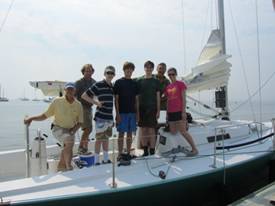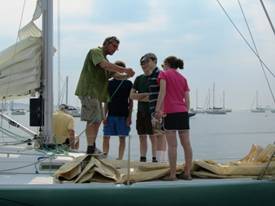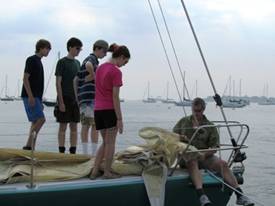Those of us of a certain age, who somehow managed to grow up around boats, dinghies at first then larger boats, find ourselves today with a large body of information and experience, not just “facts” but ways of thinking, about our sailing and are occasionally dumb struck by what folks do on their boats and wonder “don’t they know better”?
It turns out that maybe they don’t. It seems that over the past 30-40 years or so the profile of the average yacht buyer/owner has changed from someone who grew up with access to bigger boats and apprentice-like sailing adventures under the wing of someone who did know what was going on, to owners who are late comers to the activity of sailing and in many cases their first boat is a “yacht”.
In my time in the marine business, basically my whole life, much of it with Hood Sailmakers I was regularly aboard boats where even simple things like handling a winch seemed to be an unknown. This had caused me to ponder the question, why don’t they know and of course one does not get to know something unless you either figure it out (by trial and error) or one is instructed by someone who does know. Well just how do you find someone with requisite skill and experience?
This was a question a disparate group of members of the Storm Trysail Club asked themselves a while back. The answer turned into the Storm Trysail Foundation Junior Safety at Sea seminars.
These are one day hands-on instruction based on similar seminars for adults but with a modified curriculum and aimed at high school sailors. From a modest start about 13 years ago in Larchmont NY, (where the STC and its Foundation maintains an office at Larchmont YC), the STF Jr. SAS has expanded to 6 or possibly 7 venues throughout the north east US. The goal of the seminars is to instruct the kids in the arts and sciences of sailing as practiced on “big boats”. A Big boat for the purposes of discussion is a boat 30-45 feet with an inboard engine, lifelines, interior and so on capable of putting to sea.
One of my various hats is the Coach of the Prout School Sailing team. I thus have good contact with 23 high school kids with varying states of sailing skill and interest from zero to pretty good. In the NE the high school sailing season is so short, I have made it a habit to present a calendar of alternative sailing adventures the kids can do over the summer.
Thus I found myself with 4 members of my sailing team last Friday morning preparing to help me deliver a J 105 I sail on from Noank, CT to Newport RI.
Jaded had just been splashed a day or two prior so there was still lots to do, including in one case bending on the headsail. This led to a discussion on head foils, roller furling, J locks, pre-feeders, keeping the sail in the foil, (when it is not flat calm at the dock) and how to play the roles of pit, mast man & bow man emphasizing the importance of watching what your team mates are doing and non-verbal communications.
With no wind for the first couple of hours, we motored out of the Fishers Island sound. Thus the first lesson at sea was on piloting and visual navigation, the implications of different colored and shaped navigation aids, the importance of the “what is wrong with this picture” thinking, how to use a depth sounder in piloting and compass course steering.
After transiting Watch Hill passage the question from one of the kids: “are we going to sail” led to a short review of meteorology and its implications for sailors: High pressure, low pressure, gradient and thermal wind isobars, and definitions of wind. By the time that was over and lunch was had, the south westerly had built enough to make sailing a proposition, time wise.
Thus we introduced the basics of sail handling on a bigger boat, setting the mainsail, securing the halyard shackle (tighten with pliers or spike and/or seize if going on a longer passage) how to put a line on a winch, grind the winch remove the handle and take a line off or ease the line under load and the use of rope clutches. With the main up the next stop was setting the masthead 120 sqm kite. This lesson was on asymmetrical spinnakers, ATN socks, getting the kite into same, spinnaker rigging, and retractable bowsprits.
With the kite up we moved onto to the idea of “wally-ing” (the technique of coming up in light air and sailing deeper in puffs when sailing downwind) and related strategy & tactics for sailing down wind. After a discussion on the techniques of gybing A-sails, the students proceeded to peel off several (perfectly fine) gybes approaching the entrance to Narragansett Bay.
The bonus feature was sailing thru the gaggle of America’s Cup cats out practicing in the narrows between Ft. Adams and Jamestown. After one last gybe it was kite down (sock first) main down, flaked and secured, engine on, fenders and dock lines out and coming alongside the dock down tide.
A couple of the parents were already there to collect their kids and were treated to the nickel tour by their (very proud I thought) sailors. And we were only 20 minutes off the time I suggested they arrive at Conannicut Marine.
I was told by one parent, when she sent me the attached pictures, that her son had thoroughly enjoyed himself, so that is a start.
The next adventure for another 5 kids is this Saturday, sailing a J92s around Narragansett Bay.



